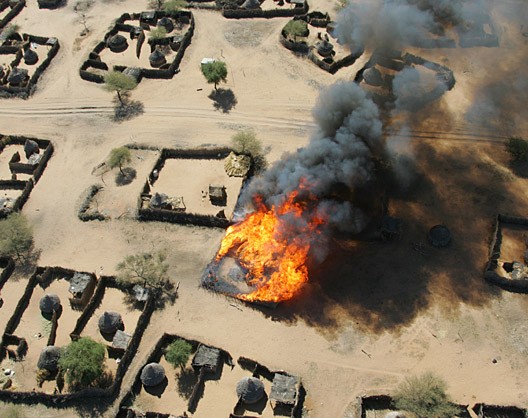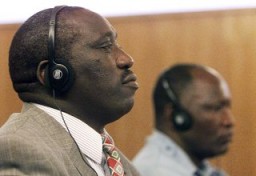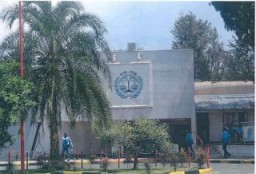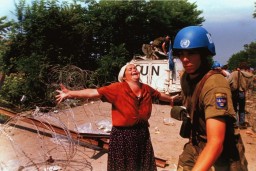
What have we learned about the risk factors and warning signs of genocide?
The study of the Holocaust raises questions about how the world can recognize and respond to indications that a country is at risk for genocide or mass atrocity. While each genocide is unique, in most places where genocide occurs, there are common risk factors and warning signs.
Explore this question to learn how to identify these signs in today's world, as well as how they were present during the Holocaust and other genocides.
See related articles for background information related to this discussion.
Risk Factors and Warning Signs
Genocides have continued to happen since the Holocaust. For example, genocide occurred in Rwanda in 1994, and at Srebrenica in Bosnia in 1995.
Every genocide is unique, but most genocides share some things in common. Just as there were key conditions that made the Holocaust possible, there are identifiable risk factors for genocide today. Some of the most common are:
- Instability: One of the strongest signs of the potential for genocide is large-scale instability. Instability can result from armed conflict or developments that threaten a regime’s power, such as a coup, revolution, or uprising. Instability may increase the risk of genocide for several reasons. Leaders may feel threatened, citizens may feel insecure, and the law may be suspended or neglected. In such environments, leaders and citizens may be more willing to consider violence to protect themselves and what they value.
- Ideology: Genocide often happens when leaders believe that some people in the country are inferior or dangerous because of their race, religion, or national or ethnic origin. In Rwanda, leaders of the Hutu majority believed that the Tutsi minority wanted to dominate the Hutus. In Bosnia, Serb leaders believed that the Muslim Bosniaks were a threat to the freedom and culture of the Orthodox Christian Serbs.
- Discrimination and violence against groups: Where genocide occurs, there usually have been earlier acts of discrimination, persecution, and violence against people who belong to a certain group. In Rwanda, Tutsis faced various forms of discrimination. There were several incidents of mass violence against Tutsis in previous decades. In addition, Bosnian Serb forces committed numerous war crimes and crimes against humanity against Bosniak and Croatian communities before committing genocide at Srebrenica.
The factors that can put a country at risk for genocide may exist for a long time without leading to genocide. Some of the warning signs that the risk for genocide may be increasing include:
- Dangerous speech: Before and during genocide, there is often widespread hate speech. Such hate speech promotes the idea that members of a certain group are evil and dangerous. When this speech comes from influential leaders and is spread through government propaganda or popular media, it can condition listeners to believe that violence against the group is justified. It may also incite some people to commit violence against members of the group. The leaders of genocide in Rwanda and Bosnia all promoted hate speech against the victims.
- Armed groups: Before committing genocide, leaders often create special groups that share their ideology and goals. For example, Hitler established the SS (Schutzstaffel; Protection Squadrons) in Germany in 1925. Leaders provide these groups with weapons and military training. They use them to commit violence against members of a particular group. During the Rwandan genocide, the Interahamwe militia led the killing in certain areas.
- Armed conflict: Genocide most often happens during armed conflict. The genocides in Rwanda and Bosnia happened during times of civil wars. The Holocaust and the genocide in Armenia occurred during international wars. Genocide can result if one or both sides of the armed conflict expands its targets from enemy soldiers to civilian groups seen as supporting the enemy. Mass atrocities against civilians who belong to a certain group can escalate violence and increase the risk for genocide by deepening hostility between groups. This can provoke acts of revenge, attract recruits to the warring sides, and provide leaders with an excuse to conduct an all-out attack on members of a group.
The specific factors that led to genocide in Europe, Rwanda, and Bosnia were very different. In each case, however, recognizable risk factors and warning signs were present. All those who organize and carry out genocide rely on the active help of countless officials and ordinary people as well as those who stand by, witness, and sometimes benefit from the persecution and murder of their neighbors.
Early Warning
Today, the international community makes efforts to watch for the risk factors and warning signs of genocide. Recognition of these signs can help the world act to prevent before killing begins. Because genocide usually occurs within the context of other mass atrocities, prevention efforts focus not only on genocide but also on the other acts defined as “atrocity crimes.” Genocide, war crimes, and crimes against humanity are today together commonly referred to as "atrocity crimes" or "mass atrocities."
As we learn more about the risk factors, warning signs, and triggering events that have led to genocide in the past, we are also learning ways to prevent it in the future. Designed by the Museum and Dartmouth College, the Early Warning Project gives us a first-of-its-kind tool to alert policy makers and the public to places where the risk for mass atrocities is greatest. Together, people around the world can call for action before it’s too late.
Critical Thinking Questions
- How might citizens and officials within a nation identify and respond to warning signs? What obstacles might be faced?
- How might other countries and international organizations respond to warning signs within a nation? What obstacles may exist?
- How can knowledge of the events in Germany and Europe before the Nazis came to power help citizens today respond to threats of genocide and mass atrocity?










